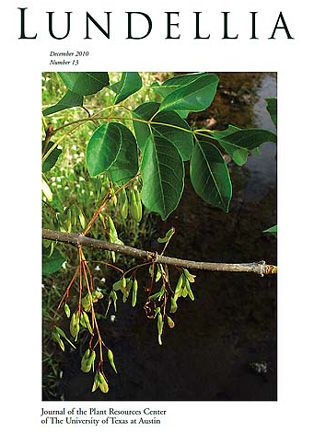
Journal of the Plant Resources Center of the University of Texas at Austin
Number 13 — December 2010
[Published: 3 December 2010]
Contents:
Abstracts
Transfer of Hymenoxys argentea var. thoreauensis to Tetraneuris (Asteraceae: Helenieae: Tetraneuridinae)
Mark W. Bierner and Billie L. Turner
1—2
Abstract: Based on evidence supporting the recognition of Tetraneuris as a genus separate from Hymenoxys, Hymenoxys argentea var. thoreauensis is basionym of a new combination, Tetraneuris argentea var. thoreauensis.
Return to Vol. 13 Contents
Benjamin Carroll Tharp (1885–1964): Remembering A Life Fashioned of Events and Circumstances
Alan Graham
3—9
Abstract: Benjamin Carroll Tharp was a legendary Texas botanist who made fundamental contributions to understanding the vegetation of the state and to developing the University of Texas Herbarium. His publications in the early and middle 1900s were used by numerous writers and artists in the southwest, and throughout his career he contributed generously to students and colleagues needing field collections for teaching and research. Later, however, he became caught up in the changing trends in botany that shifted staffing, administration, and departmental emphasis away from descriptive field studies and more toward laboratory and experimental research and newer methodologies. He was also concerned in later years with completing a lengthy treatise on soil-vegetation relationships and soil development in non-glaciated regions. The result of these many factors was a complex individual with deep feelings for his native state and great respect for those studying its natural history. He also harbored resentments and anxieties manifested as a stoic personality easily interpreted as bitter and even angry. He was all of these but for those closest to him he was admired for his deep reservoir of knowledge about plants which he shared generously with those devoted to Texas and its vegetation.
Return to Vol. 13 Contents
New Taxon in Psacalium (Asteraceae: Senecioneae) from Oaxaca, Mexico
Billie L. Turner
10—13
Abstract: A new peltate-leaved taxon of Psacalium, Psacalium putlanum, is described and illustrated from southwestern Oaxaca, Mexico. It appears to be closely related to them widespread P. peltigerum. Additionally, the closely related P. peltigerum var. latilobum Pippen of Guerrero is elevated to specific rank as P. latilobum (Pippen) B.L. Turner. A phototype and drawing of P. putlanum are provided, along with a map showing the distribution of the taxa concerned.
Return to Vol. 13 Contents
The Status of Fraxinus papillosa (Oleaceae): SEM Study of Epidermal Features
Justin K. Williams and Guy L. Nesom
14—NN
Abstract: The abaxial leaf surfaces of Fraxinus in the southwestern USA and northwestern Mexico are sometimes white-glaucous and have been described as “papillose.” Individuals exhibiting this morphology have been identified as F. papillosa, a species reported from Arizona, New Mexico, Texas, and Mexico. In the original description of F. papillosa, its leaf epidermal structure was compared to F. americana L., but the abaxial surface morphology of F. papillosa is distinctly different from that of F. americana. In the latter, a cuticular reticulum overlays the epidermis and partially obscures it, while the abaxial surface of F. papillosa is similar to that of F. velutina in its lack of a cuticular overlay. In F. papillosa each epidermal cell is abruptly convex or folded upward into a papilla-like structure, compared to the relatively flat-surfaced cells of F. velutina – intergradation occurs but whether the two are appropriately considered conspecific remains to be determined. SEM photographs of the abaxial leaf surface morphology of F. papillosa, F. velutina, and other species that are similar to F. papillosa are provided.
Return to Vol. 13 Contents
 Lundellia Home Page
Lundellia Home Page
U. Texas at Austin | Plant Resources Center | Contact Us